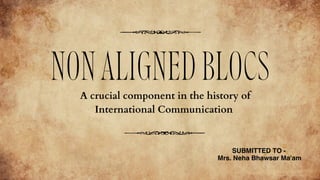
Non-Aligned Movement & its relevance.pdf
- 1. NONALIGNEDBLOCS SUBMITTED TO - Mrs. Neha Bhawsar Ma'am A crucial component in the history of International Communication
- 2. 01/ Introduction to Non Aligned Blocs 02/ Emergence & Key Features 03/ Challenges and criticisms 04/ Present Phase & Future Prospects 05/ Conclusion CONTENTS
- 3. INTRODUCTION The Non-Aligned Movement (NAM) is a group of states not formally aligned with or against any major power bloc. It emerged during the Cold War as countries sought to assert independence from the influence of the United States and Soviet Union. The movement aimed to promote sovereignty, self-determination, and global peace. Non-Aligned Blocs are subsets within the NAM consisting of countries with similar geopolitical interests or concerns. These blocs collaborate on issues such as economic development, disarmament, and human rights, while maintaining autonomy in foreign policy. NAM remains relevant today, advocating for multipolarism and addressing contemporary global challenges.
- 4. HISTORY THAT'S ROOTED BEHIND The Non-Aligned Movement (NAM) emerged during the Cold War as a response to the bipolar world order dominated by the United States and the Soviet Union.The reasons behind its emergence were rooted in the desire of newly decolonized nations to avoid alignment with either the Western capitalist bloc or the Eastern communist bloc. These countries faced pressure from the superpowers to choose sides in the Cold War, which often resulted in interference in their internal affairs and exploitation of their resources. By remaining non-aligned, member states sought to pursue their own national interests, promote economic development, and assert their sovereignty on the international stage without being drawn into the ideological conflicts of the Cold War. The Non-Aligned Movement provided a platform for these countries to collectively advocate for their interests, voice their concerns, and pursue mutual cooperation on issues such as disarmament, development, and human rights.
- 5. The Non-Aligned Movement (NAM) emerged from the 'Bandung Conference' in 1955, where leaders of 29 newly independent nations, primarily from Africa and Asia, met to promote peace and independence. They aimed to distance themselves from the Cold War superpower rivalry between the US and USSR, advocating for neutrality and self- determination. This led to the formation of the Non-Aligned Blocs, which sought to navigate global politics independently, avoiding alignment with either major power bloc. The Bandung Conference laid the groundwork for NAM's principles of non-alignment, cooperation, and mutual respect among nations, shaping post-colonial international relations. ORIGIN OF THE MOVEMENT
- 6. FORMATION The Non-Aligned Movement (NAM) officially formed at the 1961 Belgrade Conference, where leaders from newly independent countries gathered to promote neutrality in the Cold War. The movement aimed to assert sovereignty, peaceful coexistence, and non-interference. The conference marked the birth of the Non-Aligned Blocs, a collective of nations pursuing a middle path amidst Cold War tensions. Led by figures like Jawaharlal Nehru, Abdel Nasser, Sukarno and Josip Broz Tito, NAM became a platform for decolonization, global peace, and development. Its formation reshaped international relations, emphasizing autonomy and unity among developing nations.
- 7. Panchsheel Principles: Five principles of peaceful coexistence: mutual respect for sovereignty and territorial integrity, mutual non-aggression, mutual non-interference in internal affairs, equality and mutual benefit, and peaceful coexistence. NAM Core Values: Advocacy for global peace, anti-imperialism, anti-colonialism, and anti- neocolonialism. Sovereignty: Emphasis on national sovereignty and independence, rejecting alignment with any major power blocs. Third World Solidarity: Support for developing nations' rights and aspirations, particularly in economic development and social justice. Diversity: Recognition and respect for the diversity of cultures, ideologies, and systems among member states. KEYPRINCIPLES&PANCHCHEEL
- 8. CHALLENGESFACEDBYTHE'NAB' Ideological diversity: Struggles to maintain unity among member states due to differing political ideologies. Perceived irrelevance: Criticisms of ineffectiveness in addressing global issues amidst the rise of new power dynamics. Lack of cohesive agenda: Difficulty in establishing common goals and strategies among diverse member nations. Allegations of hypocrisy: Accusations of member states engaging in actions contrary to non- aligned principles. Economic dependency: Challenges in fostering economic self-reliance and reducing reliance on major powers. Influence of major powers: Pressure from global powers to align with their interests, undermining the movement's autonomy. Regional conflicts: Internal disputes and conflicts within member regions hinder collective action.
- 9. PRESENTPHASE&FUTUREPROSPECTS As the host of the 19th summit, Uganda played a significant role in shaping the agenda and discussions.Uganda highlighted its commitment to advancing the interests of developing countries within the NAM framework, particularly in areas such as peace and security, sustainable development, and South-South cooperation. President Yoweri Museveni emphasized the need for unity and solidarity among NAM member states to address shared challenges and promote the interests of the Global South. Its future strategies include: Strengthening Unity Promoting Multilateralism Addressing Contemporary Challenges Enhancing South-South Cooperation
- 10. CONCLUSION The Non-Aligned Movement (NAM) emerged during the Cold War as a coalition of states seeking to maintain independence from the influence of major powers. Comprised of over 120 member countries, NAM advocated for principles of sovereignty, non-interference, and mutual cooperation. While the bloc's relevance has evolved with geopolitical shifts, its core values remain pertinent in addressing contemporary global challenges. In today's interconnected world, NAM continues to serve as a platform for fostering dialogue, promoting peace, and advancing the interests of its diverse membership. Despite varying perspectives and challenges, the Non-Aligned Movement endures as a symbol of solidarity and resilience on the international stage.